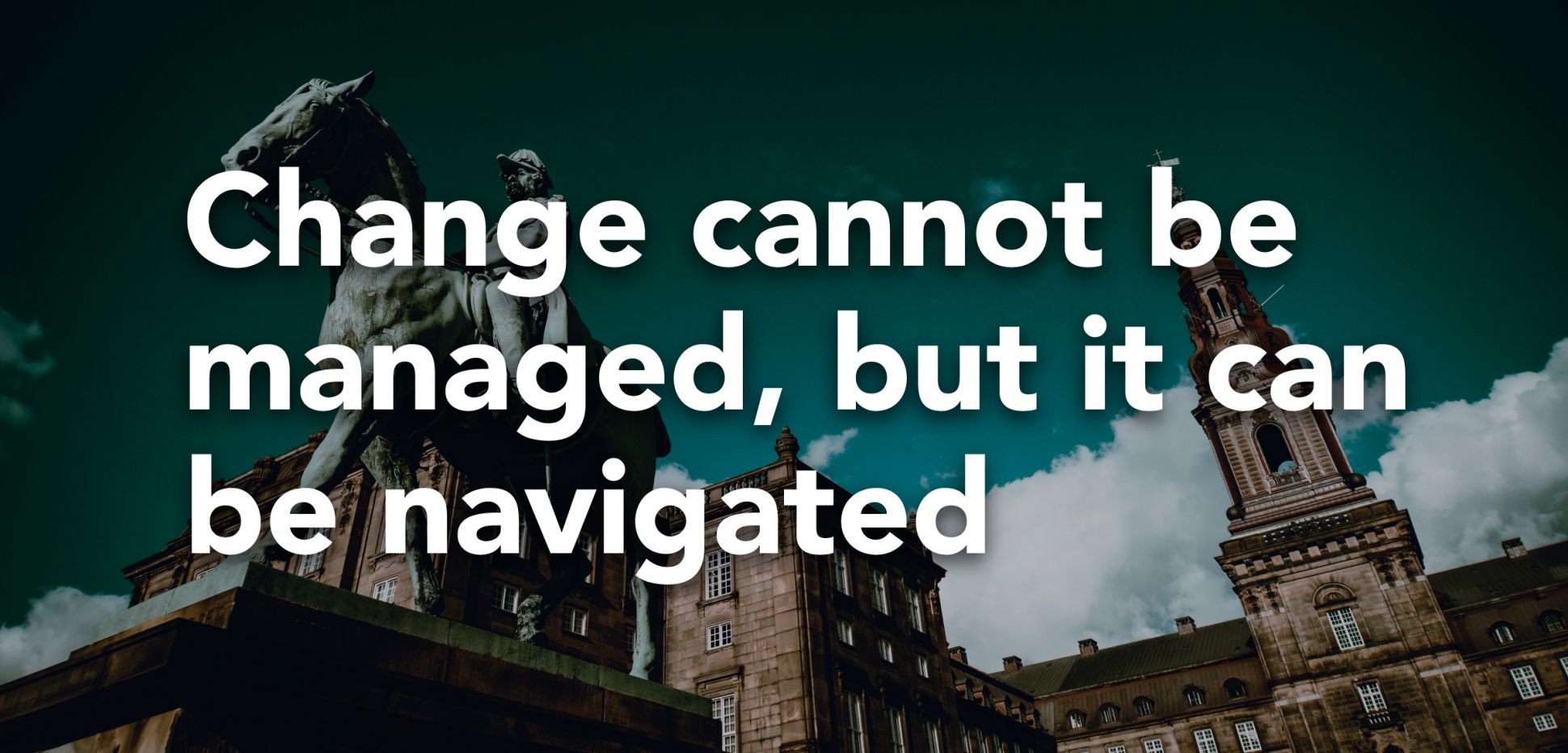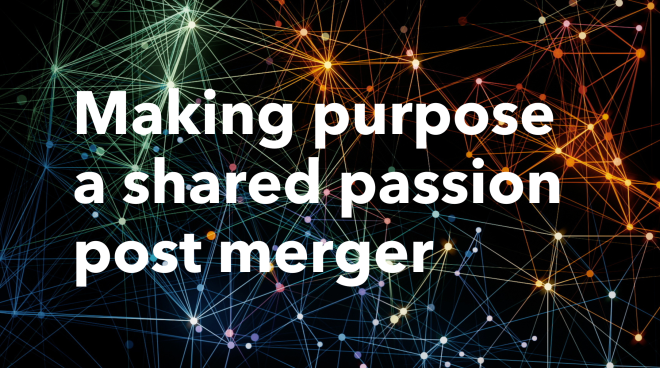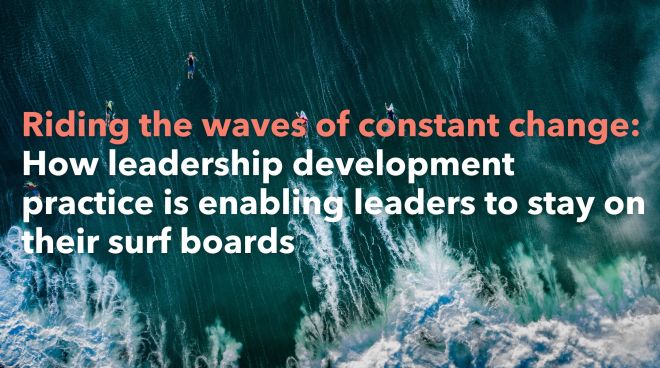Don't Manage Change

It is estimated that 70% of all change programmes fail. Yet organisations still embark on major change programmes with a voracious appetite, adopting change methodologies and practices that lay out change in one linear path. Here, we look at the world of change management, and why more than ever we need to focus on the human system above all else to ensure change succeeds. But first, we begin with that Netflix phenomenon, Borgen!
In past years, one show that has riveted us is Borgen, the Danish drama focusing on a first-term prime minister as she builds her coalition and carries out (or at least tries to!) her vision. We were intrigued at how well the program captures the prime minister’s complex task of negotiating policy changes. She faces political haggling, human frailty, unexpected consequences and a battle for meaning. Reality bears little relationship to her manifesto.
You know this from the reality of your own companies. This is why it is unsurprising that 70% of planned changes fail their initial aims. McKinsey did the research(1). Board members need awareness of this as companies commit to transformation. Our experience shows that Boards and Senior Management are obsessed with Change Methodology, the set of procedures that cause change to happen.
Competing firms argue that their steps are best. Boards look for rational, well-laid out plans that guarantee the desired outcomes of a change campaign. Change is recognised as a constant, sometimes unwelcome, element of our daily lives. Much has been written about how we can cope with and manage changes, both on a personal and organisational level.
A Google search of ‘Managing Change’ yields over 21,400,000 pages devoted to techniques for managing this process. Interestingly, if you search for ‘Why Change Fails’ the number rises above 416,000,000! So there is no scarcity of wisdom on the knowledge, skills and strategies that help us fathom this organisational conundrum. With such insights available, and with many consultancies offering support, why is the magical solution so elusive?
Sheppard Moscow is no stranger to working with organisations who are grappling with this challenge, and we want to share our perspectives on some of the missing links in the complex world of navigating change.
Step back for a minute and reflect on something different. A client, who has just speedily and effectively outsourced the entire transactional finance operation to a third party, identified the following factors:
- Having the board member with her
- The tenacity of the change managers
- Adaptability to unexpected issues and obstacles with one eye on the prize
There was no mention of an excellent methodology! Business change is always about changing the Human Systems in our organisations. We have always known this yet we don’t know how to incorporate it into practice. Organisations are made up of free-willed human beings who decide rationally and irrationally to join new directions or ways of doing business. This is why we encounter unintended consequences, rigidity and mess in the change process.
Any genuine change agent will tell you that change is messy. We need to realise that our structured plans, while necessary stabilising mechanisms are not the reality of change as it unfolds. The key to change is successful implementation; the key to implementation lies not in project planning but in orientation to individuals and their dynamics in groups.
All too often we get involved when organisations are dealing with the aftermath of a change initiative, often following the launch of business transformation programmes supported by large consulting and strategy houses that did not live up to expectations.
These organisations were not blind to the challenges of managing change, and many had been advised on, and followed, the well-researched and respected approaches to change, for example:
- Defining a clear ‘burning platform’ for change
- Creating a sense of urgency and momentum around the change
- Creating and communicating a clear vision
- Building change leadership
- Managing and involving key stakeholders
- Engaging employees in the change process
In our experience, most of the approaches to change try to impose what are essentially neat, logical and structured processes and approaches on organisations, which are inherently messy and complex. Organisations have their own cultures, with patterns of doing things, which need to be respected and worked with.
Change can rarely be managed but can be navigated. It is as much an art as a science and as such most organisations need the support of skilled change practitioners who can help them plot their own change journey. Implementation of change is the key and although less ‘sexy’ than identifying bold new strategic direction execution is what delivers the business benefit. Implementation is often misunderstood. Our core proposition is that if a business is to successfully change it will need to change its culture which in turn results from a fundamental change in mindsets, habits and practices of its members. Change happens from within the everyday conversations of its people, after all, do conversations remain the same or do they change?
A successful business turnaround, reorganisation or merger demands a change in the DNA of your organisation. Mindset, behaviours, habits need to change. But the DNA is hard to spot, let alone alter because it is also your DNA too. What we mean by an organisation’s DNA is the implicit ways of working that people go along with but few openly discuss, for example:
- The power of the silo functions
- The need for consensus before any decisions are taken
- The shifting of the ‘problem’ to another function or person
- How failure is dealt with
- Who actually makes decisions and the processes by which they are made or know
These are often so subtle that even those in the organisation may fail to see these patterns. They then wonder why they continue to get the same results when they keep relying on the same ways of tackling problems.
The resulting impact and ‘cost’ to the organisation include:
- Wasted energy and activity but no real progress and action
- Disengaged and disillusioned staff who see this as ‘yet another’ change activity that will not deliver results
- Initial compliance, at best, to change but reverting to old behaviours once the focus moves to the next change process
- Protracted decision making and implementation of change which fails to meet expectations of stakeholders around the benefits of change
When we introduce change, the underlying thinking is that when staff hears the logic they will adopt the new, see sense and come on board. The unspoken assumption is ‘we expect you to be logical and accept this argument and go along with change....’ Bob Marshak(2) has been very insightful: the more senior in the organisation the more prone to this weakness as they rely on a rational business case to drive change, he argues. This is the logical strategic argument to show how the present is untenable and the company needs to become something different. This case is announced continually and plans to change built up around it - yet we know how this is not the way it works, does it work for you?
In Bob’s view we neglect:
- The Aspirational – failing to inspire people by engaging their heads and hearts. People feel more compelled to act and be part of something meaningful.
- The Emotional – Unexpressed Feelings covert fears and anxieties prevent important aspects of change to be discussed. For example, executives facing failure for the first time; fight or flight behaviour driven by fear. Collective feelings of superiority complacency, arrogance are ignored.
- The Political - Differing organisational and stakeholder self-interests exist. These are often well-intentioned yet people are determined to protect or advance their interests.
Axelrod(3) criticises our very own DNA as change agents. The few decide for the many, he says, leading to exclusion resistance and lack of trust.
We believe passionately in the ability of organisations and people to change if the best conditions are created to do so. So, in working with us on change we bring:
- Respect for the differences in people and organisations that need to be acknowledged and worked with, rather than managed
- Ability to surface and challenge the patterns that keep your organisation ‘stuck’, supporting you in developing new and more productive ways of engaging around change
- Supporting leaders to have the dialogue with their organisations to really hear what needs to change; this often requires senior leaders to release some control in order to enable new discussions
- Objectivity and distance from the technical content of change; enabling us to step back and identify with clarity what is helping and hindering change
- Partnership in navigating your change with you with a focus on leaving you better equipped to implement change and be more self-sufficient
Your function at Board or Senior Executive level is to set direction. You articulate a destination and outcomes that will return value for shareholders, the WHAT of change. The message of this article is to enhance shareholder value by attending to the HOW of change by becoming a catalyst for change. Examine your own practice and provide direction beyond auditing sophisticated change management project plans submitted by senior executives, change departments or external consultants.
Ask questions that force the executive to focus on implementation and their leadership of change:
- How will the managers deal with unexpected outcomes, resistance and emerging issues
- Reflect on how previous change and current mindset is actually stemming from yourself and the board. Have we overemphasised the rational plans and smooth milestones? Do we send a message that we are not interested in the detailed implementation?
- Insist on change capability within the organisation - leaders who engage with their organisation lead change from a human systems point of view
- Rely less on the rational business case and work the other levers of change to Inspire people. Ensure your executives engage people delving into the organisation to support mindset change
To discover more about our approach to and insights about organisational change, here are a couple of relevant articles:
Acclerating business change through culture transformation
As always we are keen to hear any feedback or reflections you have. Feel free to contact jenniferrees@sheppardmoscow.com personally.
References:
- The Inconvenient Truth about Change Management. McKinsey and Company (2008)
- Marshak R., (2006) Covert Processes at Work, Berrett-Koehler San Francisco CA
- Axelrod R.H. (2010) Terms of Engagement New ways of leading and changing organisations, Berrett-Koehler San Francisco CA

 Michael Nolan
Michael Nolan  Helen Lockhart
Helen Lockhart 
 Andrea Cusack
Andrea Cusack 

 Aoife Keane
Aoife Keane